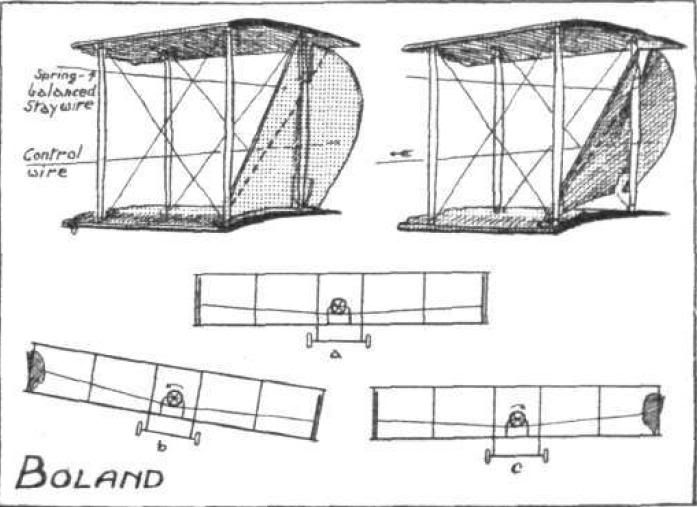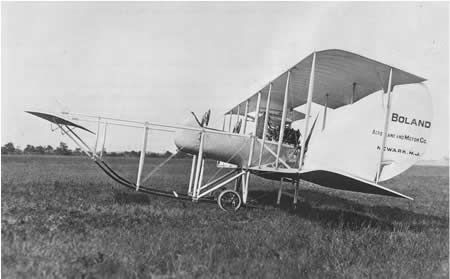Ordinarily, an aeroplane uses ailerons or wing-warping control to bank either to the left or the right. This banking movement is coordinated by means of a rudder, which controls the horizontal movement of the aeroplane, referred to in aeronautical circles as 'yaw.' The really clever bit about the Boland system is that it dispenses with ailerons and rudders entirely, and instead relies on the innovative jib system to control both axes of motion.
The jibs are roughly pear-shaped, and are pivoted about an axis at a forty-five degree angle to the horizontal. They are placed between the main planes, eliminating the heavy empennage - heretofore considered to be a necessity amongst serious aeronautical enthusiasts. The diagram here, from Flight magazine in October 1916, illustrates their use.

In ordinary flight, the jibs form side-curtains between the main planes of the machine. However, when one wishes to turn, the jib is pulled in on that side, creating a downward force of pressure on the wing, causing it to drop. Mr. Boland claims that the jib also serves in the capacity of a rudder, and that therefore it is quite impossible for his machine to side-slip during a turn. This reduces control of the aeroplane to the simplest movements possible. Using this method, the aviator has only to turn a wheel or move a control column to the left or the right, and the machine will bank flawlessly in the given direction, eliminating the need for rudder bars on the floor of the machine.
It is conceivable that lady fliers will find Mr. Boland's solution especially elegant, owing to the difficulties engendered by feminine attire. Without the need for rudder control, perhaps we will see a resurgence of skirts in the cockpit, despite Miss Harriet Quimby's comments to the contrary.
The newest Boland machine uses an elevator placed some thirteen feet in front of the nacelle to control the craft's movement in the vertical. However, owing to the excess drag of such a configuration, and its rather antiquated appearance, one wonders if perhaps a more suitable canard control system might be found - one which takes full advantage of the reduction in weight offered by the Boland's tail-less configuration.

Conceivably, the Boland machine offers many qualities sought after in a potential fighting scout. Its weight-saving tail-less configuration could be propelled with a comparatively small motor, and still achieve a good rate of speed. The design is easy to fly, and even poorly-trained soldiers would be able to control the machine in a very short time. Furthermore, the pusher configuration is an elegant solution to the deucedly difficult problem of firing a machine gun through the propeller. Whether or not this machine will stand the test of time is anyone's guess, but it remains a model of innovation in the field of aviation.

No comments:
Post a Comment